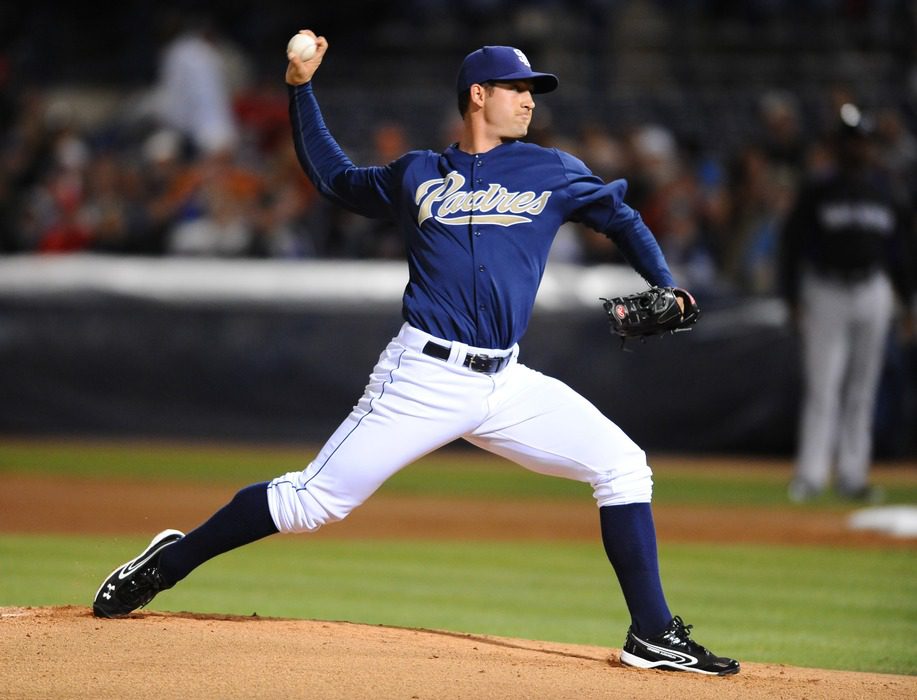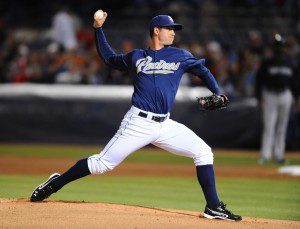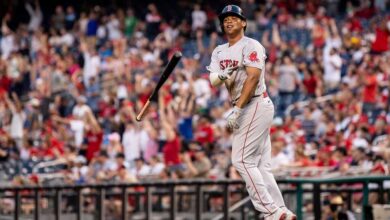

The San Diego Padres have called up top prospect Joe Wieland. Wieland, 22, received the word last night after triple-A Tucson’s game, which he started and was pulled in the second inning. Speculation on the blogosphere Tuesday evening was Wieland was moving up because Padres pitcher Dustin Moseley hit the DL after his MRI revealed “extensive damage” to his throwing shoulder. If the there was any skepticism, Wieland put that to rest by Tweeting the following:
@JWieland108: Greatest day of my life! My dream has finally come true!!! God is great!!!!
Tucson manager Terry Kennedy gave Wieland his childhood-dream news — he had been promoted to the show. According to the Arizona Daily Star, Kennedy told him in the dugout,”that’s enough, you have to save some bullets for Dodger Stadium on Saturday.” Suffice to say, Wieland was ecstatic. “It took me a minute to process it and then I started crying and hugging everyone in the dugout,” Wieland said smiling. “I was crying on the bench because my dream finally came true.”
The Padres have a plethora of pitching in the deepest system in baseball. Out of the Padres top pitching prospects in d0uble-A or higher — Casey Kelly, Wieland and Robbie Erlin — Wieland is the more polished of the three. The Padres will need to add Wieland to the 40-man roster, but according to Dan Hayes of the North County Times, “They’re [the Padres] still using Jose DePaula’s restricted spot.”
If you don’t know Joe Wieland by now, you should. When I did my Padres top-prospect list last year, I ranked him number seven in the Padres system. Here is a scouting report below on your newest Padre I provided in December.
Joe Wieland
Age: 22
Born: January 20, 1990
Santa Reno, Nevada
Height/Weight: 6′-3″/175
Bats/Throws: Right/Right
Drafted: 4th round, 2008
ETA: Mid-late 2012
Scouting report: Wieland came over in the Adams deal with the aforementioned Erlin. Solid mechanically. Throws from a three-quarters angle, with smooth repeatable delivery. He is another control pitcher who pounds the strike zone effortlessly. Like many pitchers on the list, Wieland is also very athletic. He is mature beyond his years. Wieland has a natural movement on his pitches. He has a two-seam and four-seam fastball, both of which have very good movement with solid sink in the lower half of the strike zone. When Wieland is on, hitters are not making hard, consistent contact. He throws his two-seam fastball about 88-90 mph, while his four-seam fastball dials up to 94 mph. His secondary pitches are starting to show plus capability. His curvball has a hard late break. His change-up, like many young pitchers’, is still a work in progress — but he’s starting to show signs of harnessing the command in the right situations, and has a nice fading action because of his smooth delivery. His willingness, accompanied with his command to throw his secondary pitches to left-handed and right-handed batters for strikes has been key, and a big part of his success. Wieland doesn’t have an overpowering fastball, so he can get into trouble when he is being inconsistent with his secondary pitches. He has the tendency to overthrow. Some scouts see him as a middle- or back-end-of-the-rotation starter. However, he has made some of the naysayers think otherwise after his stellar 2011 campaign, especially after throwing a no-hitter. He might have a higher ceiling than Erlin if he continues to mature and develop. In 2011 between three leagues (two in Texas, and one in San Antonio with the Padres) he went a combined 13-4 with a 1.97 ERA in 155.2 IP, giving up 21 BB (1.3 BB/9) and earning 150 K (8.7 SO/9).
In two games this year with triple-A Tucson (where the ball flies in the notorious PCL League), he started 0-1, in 7.2 innings pitched, giving up three earned runs, two of the home run variety, while striking out 10.




